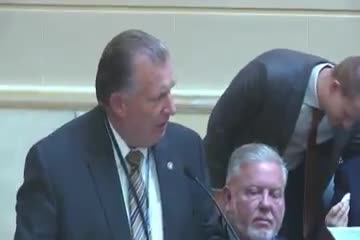House Bill 341 promotes transparency in school closure notifications in Alpine District
March 01, 2024 | 2024 Utah Legislature, Utah Legislature, Utah Legislative Branch, Utah

This article was created by AI summarizing key points discussed. AI makes mistakes, so for full details and context, please refer to the video of the full meeting. Please report any errors so we can fix them. Report an error »

The Utah Senate convened on March 1, 2024, to discuss House Bill 341, which aims to clarify the legal requirements for school closures and improve public notification processes. The bill emerged from deliberations by the Administrative Rules Committee, which had previously subpoenaed the Alpine School District to address compliance with existing laws regarding school closures.
Senator Bramble, the bill's sponsor, highlighted the need for clearer communication between school districts and the public, particularly in light of recent school closures that have sparked community concern. The bill proposes that school districts must provide adequate notice of closures, ensuring that all families, especially those in low-income areas, receive timely information.
During the meeting, Senator Fillmore introduced an amendment to streamline the notification process by removing unnecessary requirements for special education program updates, which are routinely revised. This amendment was accepted without opposition.
A significant point of discussion arose regarding the method of notification. Some senators expressed concerns about the costs associated with mailing notices, particularly for districts serving economically disadvantaged communities. Senator Weiler proposed a substitute amendment allowing districts to notify families via email or by sending notices home with students, arguing that these methods could be more effective than traditional mail.
However, Senator Bramble opposed this substitute, emphasizing the importance of using postal services to ensure comprehensive notification. He argued that relying on students to bring home notices or on email communication could lead to missed notifications, particularly for families facing housing instability.
The debate highlighted the tension between ensuring transparency in school closure processes and managing the logistical and financial implications for school districts. Ultimately, the Senate voted against the substitute amendment, reaffirming the original bill's approach to notification.
As the session progressed, various senators underscored the importance of maintaining open lines of communication with the public regarding school closures, recognizing the emotional impact these decisions can have on communities. The bill, as amended, aims to create a more transparent process for school closures, ensuring that all stakeholders are informed and can participate in discussions about the future of their local schools.
Senator Bramble, the bill's sponsor, highlighted the need for clearer communication between school districts and the public, particularly in light of recent school closures that have sparked community concern. The bill proposes that school districts must provide adequate notice of closures, ensuring that all families, especially those in low-income areas, receive timely information.
During the meeting, Senator Fillmore introduced an amendment to streamline the notification process by removing unnecessary requirements for special education program updates, which are routinely revised. This amendment was accepted without opposition.
A significant point of discussion arose regarding the method of notification. Some senators expressed concerns about the costs associated with mailing notices, particularly for districts serving economically disadvantaged communities. Senator Weiler proposed a substitute amendment allowing districts to notify families via email or by sending notices home with students, arguing that these methods could be more effective than traditional mail.
However, Senator Bramble opposed this substitute, emphasizing the importance of using postal services to ensure comprehensive notification. He argued that relying on students to bring home notices or on email communication could lead to missed notifications, particularly for families facing housing instability.
The debate highlighted the tension between ensuring transparency in school closure processes and managing the logistical and financial implications for school districts. Ultimately, the Senate voted against the substitute amendment, reaffirming the original bill's approach to notification.
As the session progressed, various senators underscored the importance of maintaining open lines of communication with the public regarding school closures, recognizing the emotional impact these decisions can have on communities. The bill, as amended, aims to create a more transparent process for school closures, ensuring that all stakeholders are informed and can participate in discussions about the future of their local schools.
View full meeting
This article is based on a recent meeting—watch the full video and explore the complete transcript for deeper insights into the discussion.
View full meeting

